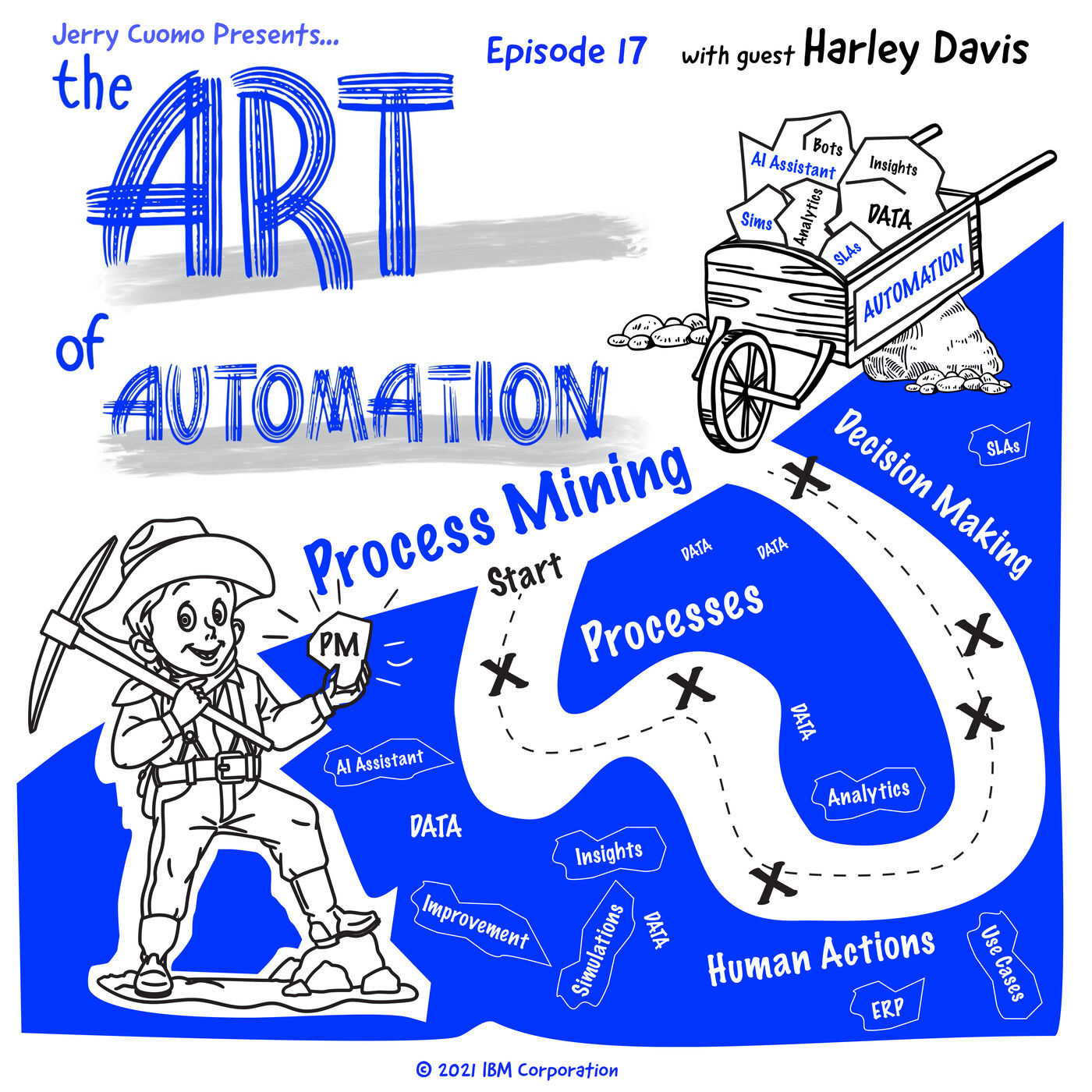Automation and Process Mining with Harley Davis
- 0.5
- 1
- 1.25
- 1.5
- 1.75
- 2
Ethan: From IBM Cloud and Cognitive Software, you are listening to the Art of Automation, with host, Jerry Cuomo.
Jerry Cuomo: Hey, and thank you, Ethan. Welcome to the Art of Automation, a podcast that explores the application of automation in the enterprise. What is automation you ask? Well, automation is simply the use of technology to automate tasks that once were performed exclusively by us humans. After several episodes on a wide variety of topics related to AI power automation, I often find myself feeling your follow on questions about the episodes, but one question stands out above all the others as the most frequently asked question, and that is, where do we start? Well, today's episode is probably our best answer to that question because if I were to pick one place, or should I say one technology to start your automation journey, it would be to start with process mining, which is the topic of this episode. What exactly is process mining you ask? Well, the analyst firm Gartner defines process mining as, a technique to sign, to discover, monitor and improve real processes, by extracting ready available knowledge from the event logs of your information systems. And it goes on to say, process mining includes automated process discovery, conformance checking, automated construction of simulation models, case predictions, and history based recommendations. And if you were to ask me, "Jerry, who is the first person to talk to you about process mining and share all its wonders and benefits?" I would say it was our featured guest for this episode, Harley Davis. Harley is our VP of Automation Intelligence, as well as our lab executive of our IBM France Development Lab. As I said, Harley has been a mentor of mine for years, pointing out the opportunities and benefits around intelligent automation. Harley has his early roots with ILOG, a company that IBM acquired many years ago. With ILOG, we were fortunate to have experts like Harley, join IBM and bring on expertise in areas including process optimization and intelligent decision automation. And with that, I'd like to welcome Harley to the Art of Automation.
Harley Davis: Hi Jerry. Thanks for having me on today. I really appreciate it.
Jerry Cuomo: Yeah, I'm excited about this discussion here. Harley, let's get to our first question, if you don't mind. First question is right up Main Street. Why are you so excited about process mining and can you share the problem it solves for users?
Harley Davis: Oh geez, sure. We've been in this automation field for ages and we have a huge amount of capability that we can bring to the table with our automation. We can automate business processes, we can automate decisions, we can automate human actions, we can do so much, but customers are always trying to figure out how to improve their operations, how to provide better business services for their customers. And they think automation has a big role to play in that. And we have a lot of cases that prove that they do. But the question that they always ask themselves is, where do we get started? How do we know it's going to work? How do we know what our people are doing today so that we can make things work better tomorrow? And up to now, the way that you answer those questions is you interview people, you look at things, you kind of do it by sniffing and guessing, a little detective work. And so Process mining is a data driven way to get that information, to figure out what's really going on in your organization, getting down to the actions that people take, whether it's on their desktop or the systems they interact with, gathering up all that data together and figuring out what's going on so that you can use that analysis and those insights, to figure out what you do next, in a much more structured way. And even going beyond that, being able to simulate what you might want to do next and being able to create this dynamic model of your organization using process mining that you can then play with before you actually do any actual automation. This solves a huge gap at the most important point in the automation journey, which is, when you start and how do you know that you get started right?
Jerry Cuomo: Harley, I really like where you're going there. This is all about where to get started. Now I want to go into this just a little bit more detail. What I'm hearing you say is that sometimes clients just don't know where to start, specifically, what their processes today really do. And they don't have a digital fingerprint of really how a process, they may think they know. When they get started, at first they want to do is prove with data evidence, what their processes are really doing.
Harley Davis: Exactly. And that data's available now. This is one of the many areas that's kind of enabled by our ability these days to collect, manage and analyze process, large amounts of data. And in this case we're talking about historical data, in some cases dating back months or years of how people actually do their work. We're talking about gathering very fine grained data of how people interact and do their work on the desktop. And the fact that we can now manage all that data and analyze it gives us this opportunity to do better than guesswork.
Jerry Cuomo: In preparation for this, what does a customer have to do? Kind of a turned lights on to get started to mine the data that's behind key business processes. Is it a significant amount of work, heavy lifting? Does it take years to do? Tell us a little bit about the prep.
Harley Davis: Getting access to the data and getting into the system is certainly the biggest part of the work. The actual process mining is a really powerful analytics engine with a great UI on top of it, that is very easy for a business person to use. The real trick is getting the data and figuring out enough about your process and enough about where you want to focus in your business, so you know where to get that data from. And that data typically comes from the logs of business systems that people interact with. Things like ERP systems or CRM systems, or you can start recording appropriate types of interactions right on a person's desktop and store that and feed it into the process mining system. We call that task mining.
Jerry Cuomo: I see. Harley help us here. Tell us a little bit more about how process mining helps jump the tracks from gaining insights from your processes to automated action. Maybe you can go into a little bit more detail about, you said a process mining tool. What does the tool actually do to help you gain insights and then drive actions? Tell us about these tools.
Harley Davis: Right. Once you actually find your data and feed it into the system, you run the analytics engine and then it gives you just all sorts of different views and insights into your data. It can tell you what the process actually looks like, where there are bottlenecks in the process, where you're spending the most time, where people are repeating actions over and over again, which might mean that they're making mistakes. And so there's an opportunity to help them not make mistakes or to make decisions for them. It can tell you how you're doing against different KPIs that you define, whether you're meeting the SLAs that you promise to your customers, and if you're not meeting them, you can double click into that and figure out what are the different variants of your process or different use cases where you're not meeting them. So you might identify that there's some particular vendor that's always a problem for payments, or you might figure out that this kind of product that you're trying to work with your customers on, has configuration issues and that slows down the process. With process mining, you can really get all the way down to that level of detail to understand where improvements can be made. And that naturally leads to where you want to apply automation. It leads you to understand where you might want to apply an AI enabled assistant to help you accomplish tasks better. It might lead you to understand where you want to do an RPA bot because people are doing the same thing over and over again and doing it slowly and inefficiently and with errors. You might want to put in place a automated decision using our decision management to make a decision automatically that people don't make so well.
Jerry Cuomo: Okay, step one, instrument your systems, collect data. Step two, use a process mining tool to visualize the data and its relationships through a process map. I think that's what you're describing and perhaps even peaks your curiosity about things that meets your intuition, " Yeah, I think the process runs this way," or maybe makes you scratch your head and say, " Hmm, why is this happening? Let me dig a little further." It provides a way to run mental simulations against what you think should be happening. Tell us a little bit more about how process mining aids in the automation and action process.
Harley Davis: A few different ways. Like I said, it kind of pinpoints where you may want to put in place automations, but it also helps simulate how things would improve if you actually put in place certain types of automations. For example, you can say, what if I used an RPA bot for 50% of cases that are coming through this arm of the process by automating the most lengthy and error prone things that people do? What would that overall impact on my SLA be? And if it's a significant improvement, then you actually want to go ahead and do that. It really ties the knot off between understanding what's going on today and what you want to do tomorrow to make things better.
Jerry Cuomo: And Harley, I heard you actually use the term a digital twin. When you're running these simulations, it's almost like you've captured a replica and now you're running simulations against that replica that is based on real data. And I would assume that, that's much more efficient than running across the live system. But you'll have evidence, you'll have data by running the simulations through the twin where and how and perhaps how much it's going to save or what kinds of improvement you can deliver to your overall experience.
Harley Davis: That's exactly right. That's the main thing that they're getting out of it, is creating this digital twin. And then the uses that you can put it to are actually quite large. Right now,, our focus is helping them use it to create better automations, but in the future, we're going to use that digital twin for so much more and we're going to feed it with so much more data because we talk a lot about using process mining for historical data analysis, but what about real time data analysis and really observing today, right now what's going on in your systems with events that are fed from all your different business systems and being able to use that to know now that things are going wrong, not just what happened two months ago or three months ago.
Jerry Cuomo: Harley, can you talk a little bit about the role of AI in process mining, both perhaps present and future?
Harley Davis: There is a little bit of AI in the process mining itself. First it's a complex time series analytics engine, which is a lot of similarities to a lot of AI algorithms, but that's not really the main thing. I think the main thing is to help address a related challenge to what we talked about before, which is investing in AI machine learning models and other AI technologies, is still fairly expensive and an elaborate process that companies need to really be sure that they're going to get an ROI on. And what process mining can do is tell you, if you had for example, an AI enabled assistant that was working together with people, like a kind of digital worker, that's working together with people, what difference is that really going to make to your organization, and does that help justify the investment in doing the kind of data analysis, feature engineering, data science work that you need to make AI come to fruition in the enterprise?
Jerry Cuomo: And Harley, we've been speaking somewhat abstractly about process mining tools and there's a variety of tools on the market today and I know you happen to be influential on bringing one such tool into the IBM portfolio of automation. I want to give you a chance to talk about that particular tool, what's its name, and a little bit about how it goes about doing things.
Harley Davis: Yes we worked and now we've acquired a company called myInvenio which it's a fairly small Italian company that has extremely strong potential in the context of IBM. The reason we're excited about myInvenio, in particular is first of all, we have actual working experience from several years of via partnering with them, of customers that we've worked on together where their process mining and our digital business automation have worked together in the same environments. But also their vision of where they want to take the technology and what they're building into their technology is super exciting for us and super synergistic with what we do. One simple example, they have the ability in their tool to do business rule mining. In other words, they can not only analyze the process flow through an organization, but they can say at different decision points in that process flow based on the data they get, what were the business rules that led to a decision being made one way or another? And that's the germ for creating decision models that we can implement using our tools. It can go from analyzing data almost directly to creating actual automations using our tools. And really no other system on the market has that kind of capability.
Jerry Cuomo: Going directly from mining your processes, visualizing, simulating to generating RPA scripts directly.
Harley Davis: Exactly. And there's all sorts of other examples like that where the myInvenio idea, the way that they've attacked their product is completely synergistic with us. Whether it's from leveraging the kind of process models that you can create using Blue Works Live, or whether it's generating BPMN models that you can import directly into our workflow tools or whether, like you said, whether it's integrating directly with RPA, and I think that's something that we're super excited about attacking in the near future without making any timing commitments, which is leveraging that information we get around how tasks are done to automatically generating RPA bots. And that is going to make a huge difference to our customers.
Jerry Cuomo: Harley, I'd like to really thank you for answering the most fundamental question about AI powered automation, which is where do you start? So thank you very much.
Harley Davis: Thank you so much, Jerry. It was a pleasure.
Jerry Cuomo: And ladies and gentlemen, you've been listening to the Art of Automation with guest, Harley Davis. Well, that's it for today. I will include a few links to Process Mining and myInvenio in the description section of this episode. Thanks again everyone for listening. This is Jerry Cuomo, IBM Fellow and Chief Technology Officer of Automation at IBM. See you again on an upcoming episode.
DESCRIPTION
Jerry is joined by Vice President of Automation Intelligence and leader of the IBM France Development Lab, Harley Davis. They set out to answer the most frequently asked question by The Art of Automation's audience: "Where do we start"? Harley explains the concept of Process Mining and how it takes a data-driven approach to translating an enterprise's desire for improved operations into actions and automations that can actually be implemented. He also discusses how Process Mining technology allows a business to simulate (using a "Digital Twin") what would improve if certain automations are applied, removing risk and justifying AI investments.
Art by David Ryan.
IBM Process Mining: https://www.ibm.com/cloud/learn/process-mining
myInvenio: https://www.ibm.com/docs/en/cloud-paks/1.0?topic=foundation-process-mining








